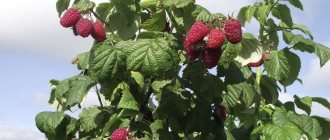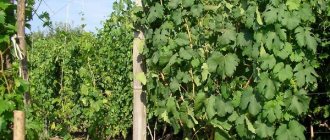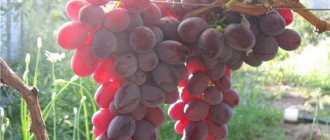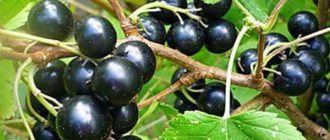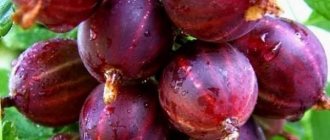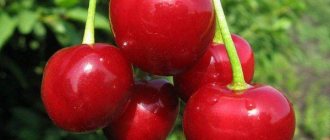Description of the raspberry variety Glen Coe
As already noted, Glen Coe raspberries are a thornless variety, which is still rare. But when planting, gardeners pay attention to other features of plants:
- the size of the shoots;
- the possibility of obtaining shoots for further reproduction;
- size and taste of berries;
- features of the use of the crop.
Bushes
The height of the shoots of the exotic raspberry variety Glen Coe is about 1.5-2 m. The plant stands out among other plantings due to its compactness and powerful spreading shoots, which require mandatory tying.
There are no thorns on the branches at all, even the smallest ones. Fruiting of Glen Coe raspberries occurs on flexible shoots of the 2nd year. In the first summer, flower buds form on them. The formation of replacement shoots is sufficient, so there are no problems with reproduction.
The leaf blades are large, juicy green in color. Shape: trifoliate or odd-pinnate.
Fruit
Raspberry Glen Coe is still a rare guest on Russian plots. But once you see large pink-purple berries, it’s hard to resist planting the plant in the garden. Each fruit is covered with a waxy coating, visible from afar. The berries are aromatic, with a sweet taste and blackberry aroma.
The shape of Glen Coe raspberries is conical, with 7-9 berries formed on each bunch. The weight of each of them is about 5 g. The collection of berries will take a long time, since the ripening is uneven.
Important! Fruit detachment is dry. Even overripe berries of the variety do not crumble and do not lose their visual appeal and taste.
The crop can be grown throughout Russia, only in the Northern regions it will be necessary to cover the shoots of the 1st year for the winter.
How to care for raspberries
Caring for Glen Coe raspberries is not difficult. You need to follow standard care rules, then the bushes will be able to develop and bear fruit normally.
- It is necessary to water Glen Coe raspberries in moderation so that the soil is neither dry nor swampy.
- From time to time you need to loosen the soil between the rows and under the bushes so that it does not become crusty. At the same time, all weeds and fallen leaves are removed.
- For normal growing, bushes are best tied up. This is done so that it is convenient to move between the rows and so that there is not a large load on the pagons during the ripening of the berries.
- Fertilizing is carried out mineral and organic. Mullein for feeding is bred in a ratio of 1:7, litter - 1:18. Herbal infusion of nettle or any other herb is made in a 1:9 ratio with water. You can take superphosphate from minerals. For 50 g of fertilizer, take 10 liters of water. During the season, an average of 3 feedings are carried out - during flowering, pouring berries and after harvesting. After fertilizing, it is important to water the bushes.
Mulching raspberries with sawdust is not necessary, but it certainly won’t be superfluous
- To prevent the bushes from getting sick and being affected by pests, it is necessary to spray them and the ground around them with Bordeaux mixture in early spring for prevention. When leaves appear, spraying is carried out with a weak solution of potassium permanganate. When the berries ripen, you can simply dust the bushes with dry wood ash to be safe. After harvesting, spraying with Bordeaux mixture is repeated.
- For the winter, the root zone is mulched with 25-30 cm of straw. If the winters are frosty and long, it is better to bend the bushes to the ground, cover them with spruce branches or other insulating but natural material (the bushes will be locked under the film).
Important!
Organic fertilizers have a positive effect on the taste, size and aroma of berries!
Characteristics of the variety
From the description it is clear that black raspberries look great on the plot and will give a good harvest. But what characteristics does the variety have, what is its yield, how often do plants get sick - these are also important questions for gardeners who are interested in an exotic crop.
Drought resistance, frost resistance
The Glen Coe variety is frost-resistant. Young annual shoots are left for the winter. If in winter the thermometer does not drop below -20 degrees and there is a lot of snow, then it is enough to bend the bushes and sprinkle the root system with humus or compost. In more severe conditions, the shoots will have to be well insulated.
The crop is tolerant of short-term drought, but still you should not overdry the top layer of soil so as not to lose part of the harvest.
Productivity and fruiting
Glen Coe raspberries have excellent taste: the berries are sweet, aromatic, with a blackberry aftertaste. From one bush, subject to agricultural technology, you can collect about 6 kg of large fruits. They hold tightly to the stalks and do not crumble or fall apart.
Fruiting begins in mid-July and continues until frost, since the plant is a mid-season variety.
Area of application of fruits
Raspberry Glen Coe, according to reviews from gardeners and consumers, is distinguished by its versatility of use. Jam and compote are traditionally made from aromatic sweet berries. Lovers of homemade liqueurs and liqueurs use the fruits to prepare aromatic homemade drinks with rich color and aroma.
Attention! You can store fresh berries in the freezer.
Since black raspberries are harvested dry, they are easy to transport and store, which is important for summer residents growing Glen Coe raspberry bushes for sale.
Resistance to diseases and pests
The Scottish raspberry variety has good immunity, so the bushes are rarely damaged by diseases and pests. In particular, Glen Coe is rarely affected by root rot and verticillium wilt. But if other representatives of the culture grow nearby, then preventive measures should not be neglected.
Advantages and disadvantages of the variety
When choosing a new raspberry variety to plant on a plot, gardeners are interested in the positive and negative aspects of the crop.
Pros of Glen Coe black raspberry variety:
- thornless shoots;
- a bountiful harvest;
- excellent taste properties;
- rapid plant growth, with average formation of shoots;
- versatility of berries;
- the fruits do not fall off;
- high shelf life and transportability;
- average frost resistance and drought resistance of the plant;
- unpretentiousness of care;
- flexible annual shoots, which makes them easier to bend down for the winter;
- high immunity to diseases and pests.
Gardeners who have been cultivating the crop for several years do not note any disadvantages.
Reviews
There are few reviews about this raspberry, so I want to fill the gap a little. I bought a variety in an online store, blackberries and raspberries were located there in the same section, and somehow I paid attention to the yield and size of the berries, but didn’t even look at the name and what kind of plant I was buying. As a result, until the last minute I thought that the blackberries would come, judging by the dark shade, but when I received the parcel, I saw that the package indicated raspberries. I started reading reviews in more detail and thinking about how to plant them and what differences there are from regular raspberries. As a result, I didn’t read any peculiarities; I planted them in rows, leaving 50 cm between plants in a row and 1.5 m between rows. I fed them and trimmed them just like regular raspberries. Now I can safely say that in terms of agricultural technology this variety is no different and the main differences are color and taste. I love various exotic and unusual plants, so I really like this variety.
I bought this variety only because of the unusual color. Nothing has grown yet, but the seedlings have taken root well. Next year we'll see what comes of this idea. What I want to note is that the seedlings are expensive, I don’t know how growing purple raspberries differs from regular ones, but in terms of price, “Glen Coe” and black “Cumberland” were the most expensive. Dear sellers, please don’t make too much money on gardeners. We already spend more money on the garden than we get from it.
The amazing and amazing raspberry variety Glen Coe, judging by the description and reviews, is characterized by high yield, unpretentiousness and resistance to many diseases. The stunning blackberry-raspberry taste and unforgettable aroma of berries will bring aesthetic pleasure to gourmets.
Landing Features
Originators and amateur gardeners advise planting Glen Coe raspberry bushes in rows. This placement will ensure convenient care and picking of berries. Since the shoots are spreading, row spacing should be at least 1.5 m, or even better – 2 m.
Attention! When planting, you need to pay attention to the horse's neck: it is not recommended to deepen it too much to avoid fungal diseases.
Recommended timing
Planting raspberries can be planned for spring or autumn, as is convenient for the gardener. But most often the work is carried out in the autumn before frost sets in. By the next season, the plants will take root well and begin to bear fruit.
Choosing a suitable location
Before planting raspberries, you should consider the height of groundwater. It should not exceed 1.5 m, otherwise the root system will rot. Glen Coe, like other representatives of raspberry varieties, prefer well-lit places and fertile soil.
Attention! Acidic soil is not suitable for bushes. Before planting, add lime, chalk or dolomite flour.
The soil is prepared in advance: it is carefully dug up, weeds are removed along with the roots, and fertilized.
Selection and preparation of planting material
A good harvest is guaranteed only if quality seedlings are planted. You can use replacement shoots grown on the site. If you don’t have your own seedlings, then you need to purchase them from trusted sellers, but best of all, from fruit nurseries.
Young plants should have a well-developed root system. Shoots without signs of diseases and pests.
A day before planting, the bushes are soaked in a pink solution of potassium permanganate or any rooting agent. Immediately before placing the raspberries in a permanent place, the roots are dipped into a mash of clay and mullein.
Landing algorithm
Planting Glen Coe raspberries is done traditionally:
- Dig holes or trenches up to 60-70 cm deep.
- Fill one third with drainage. These could be broken bricks or stones. Experienced gardeners advise placing wood trimmings, twigs, wood chips, and weeds pulled from the area at the bottom. As they decompose, these materials feed the raspberries and warm the root system. This is especially important in early spring and winter.
- Place fertile soil mixed with humus, peat or compost on top. It is recommended to add a glass of wood ash to each bush.
- Water the planting area generously.
- Place the Glen Coe raspberry seedlings at a distance of 50 cm, spread the roots and bury them, leaving the root collar above the surface. Sprinkle soil on top and compact it.
- Water again to remove air from under the roots.
- If the root collar goes down after watering, the plant is slightly raised.
- After this, mulch the soil (at least 6-8 cm) and perform short pruning, leaving shoots 40 cm high.
If Glen Coe raspberries are planted in the fall, then after a few days the shoots are bent down and prepared for wintering.
Reproduction methods
Glen Coe chokeberry has an interesting feature: new plants can be obtained in various ways:
- rooting of apical layering;
- cuttings;
- roots;
- seeds.
Let's look at each method of propagating raspberries in more detail.
Apical layering
At the end of the growing season, you can notice interesting changes in the shoots of the Glen Coe variety. The tops of the raspberries spontaneously bend toward the ground. At the very tip of the shoot a “loop” and small leaves appear. This is a sure sign that the raspberries are ready to reproduce.
The shoot is bent to the ground, the crown is sprinkled with fertile soil. After some time, rooting occurs. You can replant new raspberry plants in autumn or spring.
Important! You need to take the offspring along with a lump of earth.
Cuttings
This is one of the common propagation options for raspberries. Cuttings are taken in the fall from well-developed and healthy bushes that have shown an excellent harvest. Cuttings should be no more than 10 centimeters. For work you need to use sharp pruners, previously disinfected.
Glen Coe black raspberry cuttings are placed in an antifungal solution and then placed in boxes. The bottom is covered with wet peat, in which future planting material is placed. It is stored in unheated rooms at above-zero temperatures - in the basement, cellar.
Advice! From time to time you need to check the condition of the moss, which should always be damp.
Glen Coe raspberry cuttings are planted in the spring, when the threat of frost has passed. To prevent weeds from complicating the development of new bushes, the soil surface must be mulched.
Propagation by roots
You need to start work by preparing a new seat. Choose an area where raspberries, potatoes, tomatoes and eggplants have not grown before. Organic fertilizers are placed in the soil and dug thoroughly. After this, the beds are prepared.
Black raspberries of the Glen Coe variety are a plant with a high survival rate. Propagation by roots is a natural way. Therefore, dug up roots, look at the photo, always have a large number of offspring ready for rooting.
Raspberry rhizomes are planted in trenches 40-50 cm deep. The dug up roots are inspected to ensure there are no signs of rotting and are laid out at some distance from each other. After this, pour in water, let it soak in and sprinkle with fertile soil.
When new Glen Coe raspberry bushes are received in the fall, the plantings are hilled up to insulate the roots. In the spring, shoots will begin to grow. Raspberry seedlings can be dug up and planted in a permanent place.
If the Glen Coe variety is propagated by root suckers in the spring, then young bushes need to be replanted in the fall, when the leaves have fallen.
Seed method
Black raspberries of the Glen Coe variety, like many other varieties, are capable of propagation by seeds. You can purchase them at a specialty store or prepare the seed yourself.
The procedure is very simple:
- choose well-ripened berries that fully comply with the description and characteristics of the variety;
- raspberry fruits are slightly dried in the sun, and then ground through a sieve, resulting in a paste of pulp and seeds;
- pour the mixture into clean water, stir, the seeds will settle to the bottom;
- spread the seed on a napkin and dry it.
Should be stored in the refrigerator in a damp canvas cloth.
In spring, Glen Coe raspberry seeds are mixed with damp sand and sown as seedlings. For the soil, take sand and peat in equal parts. After germination, raspberry seedlings require long daylight hours, so you will have to turn on the lamp. Raspberry seedlings should be watered moderately, but the top layer of soil should not be allowed to dry out.
Glen Coe seedlings are picked when 2-3 true leaves appear. Raspberries are planted in open ground when stable heat sets in. Seedlings are first given a separate bed where they are grown. Raspberries are planted in a permanent location in the fall.
Aftercare
All types of raspberry plants require watering, but cannot tolerate stagnant water. After moisture-recharging spring irrigation, the bushes are watered at the time of bud formation, flowering and berry filling. Be sure to water the bushes abundantly in September.
Important! Judging by the description, the depth of soil wetting under Glen Coe raspberries should be at least 40 cm.
It is not necessary to use mineral fertilizers as top dressing. Glen Coe raspberries respond well to infusions of mullein, chicken manure, green fermented grass and wood ash.
Young replacement shoots in early August are shortened by 10 cm so that lateral shoots appear, in the axils of which inflorescences form. The second pruning should be done in the spring.
In the spring, each raspberry shoot is tied to a trellis, and in the fall it is removed and cut out close to the surface. Young stems are laid on the soil. This is easy to do because the shoots are flexible. Humus is added under the bushes and covered.
It is not recommended to bury plants immediately; there should be vents at the ends. Full cover is carried out when night temperatures drop below -10 degrees.
Pros and cons of the variety
Gardeners prefer this variety due to its advantages:
- rapid growth of bushes;
- absence of thorns on the shoots;
- high productivity;
- resistance to high and low air temperatures;
- transportability of berries;
- resistance to diseases characteristic of the culture.
The disadvantages of the variety are the need for gartering of shoots and demanding soil nutrition during cultivation.
For your information! Some gardeners consider the need to tie long shoots to trellises as a disadvantage of this variety.
Diseases and pests, methods of control and prevention
The description says that the Glen Coe raspberry variety is resistant to diseases and pests. But it is impossible to exclude damage to the bushes. Therefore, you need to carefully inspect the plantings.
Common diseases of raspberry bushes:
- purple spot or didimella;
- powdery mildew;
- anthracnose;
- white spot (septoria);
- gray rot;
- curliness;
- mosaic;
- chlorosis.
Special drugs are used to combat it.
The following pests can be distinguished:
- aphids;
- raspberry-strawberry weevil;
- raspberry beetle;
- raspberry glass;
- ticks.
Prevention and control measures - use of insecticides.
Harvesting and processing
The berries are picked as they ripen, from about mid-summer. They do not ripen en masse, but alternately, in small batches. Glen Coe raspberries easily come away from the stalk, so there are no problems with this, and by themselves, even when overripe, they almost never fall off.
Glen Coe raspberries are easily separated from the stalk without falling off
The variety has universal application. The berries are suitable for making jam and jam. They also make delicious homemade juice, alcoholic drinks, and compotes. They are often used for baking, desserts, and fresh fruit and berry salads. But, of course, Glen Coe raspberries are most often used for fresh consumption.
Description
Glen Coe raspberries were developed by Scottish breeders in 1989. To obtain a new plant, the following mother varieties were used: Glen Prosen and Manger. In Russia, raspberries have not yet gained wide popularity, since the variety came to our expanses quite recently.
Attention! Glen Coe raspberries are the world's first variety with purple berries and a blackberry flavor.
Features of bushes
- Exotic raspberries with black berries are represented by a compact shrub 1.5-2 meters high. The shoots are powerful and spreading. During cultivation they must be tied up.
- The long shoots of Glen Coe raspberries are completely thornless. In the first year, shoots grow on which flower buds are formed. Glen Coe raspberries bear fruit on second year shoots.
- The leaves of the variety are dark green, compound, trifoliate or odd-pinnate in shape.
Fruit
The Scottish raspberry variety Glen Coe, even from the description of the berries, is exotic for Russians. Because such large pink-violet fruits have not yet been grown in gardens. A waxy coating is clearly visible on each berry, as in the photo below. The fruits of the variety are aromatic, sweet, and taste somewhat like blackberries.
The conical berries hang in clusters of 7-9 pieces. Each of them weighs 5 grams. Black fruits do not ripen at the same time, so raspberries are harvested several times.
Attention! During harvesting, the berries easily come off the stalk, do not crumble, but do not fall to the ground themselves.
Purpose
Glen Coe purple raspberries can be used to make preserves, jams, and pie fillings. The finished products acquire a surprisingly beautiful, rich red color. This is a completely natural color change after heat treatment.
You can make juices, homemade wine and spirits from the berries. Glen Coe black raspberries are delicious fresh, especially from the bush.
Native Americans have long known about the beneficial properties of raspberries with purple berries. They used raspberry fruits in the treatment of diseased joints.

